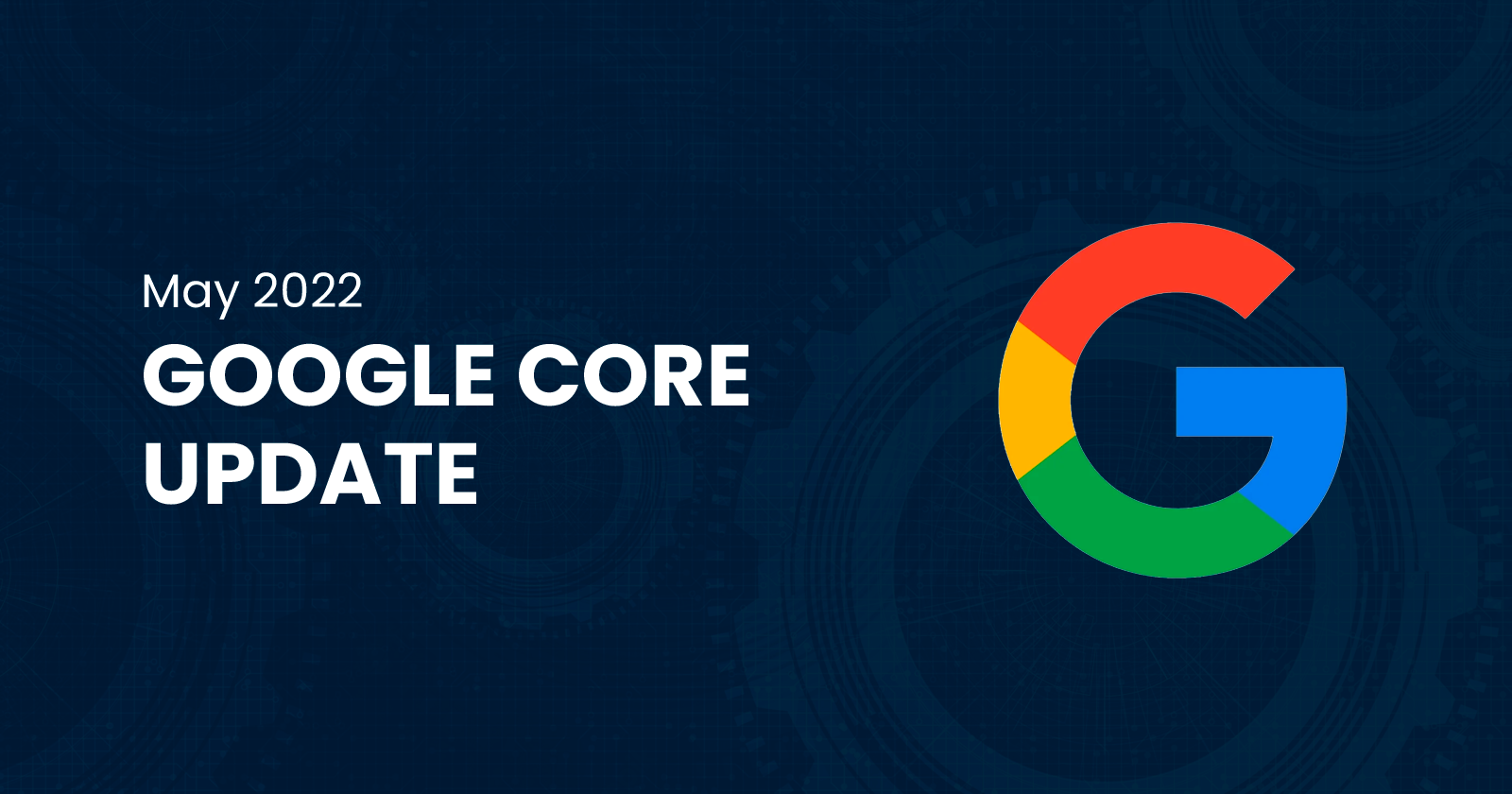The eagerly anticipated Google May 2022 core update was released on May 25, 2022, and it was finally fully implemented on June 9, 2022. This update was significant and spread swiftly across several inquiries that data providers typically monitor. After the initial upgrade, there were some ‘tremors,’ or changes in volatility; the biggest of these occurred around June 5. Websites that opted for high quality SEO services were notably able to recover faster from the jerks of the update.
Compared to the November 2021 core upgrade, the Google May 2022 core update appears to be far more important. This upgrade was timed much better for merchants than the core update in November 2021, which was released during the busiest time of year for online shopping.
Google has already offered suggestions on things to think about if a core update has a negative effect on your website. There are no precise steps to follow in order to recover, and a drop in rankings may not actually indicate that there are technical SEO issues with your website pages. The search engine giant has provided a list of inquiries to take into account if a core change affects your website, though.
The Roll-out:
Google acknowledged that there can be some recovery in between core upgrades, but the major impact would occur following another core update. Every time Google makes changes to its search ranking algorithms, your website’s performance in the search results may improve or deteriorate. Knowing when Google makes these modifications allows us to use a reference point to determine whether a change was made to your website or Google’s ranking system. It is now time to analyze how your site(s) fared with the May 2022 core update that Google issued on May 25 and has now finished. In this blog, we have taken the UK web traffic as an example to possible queries that a website owner might have. You should also take the appropriate actions to ensure that your site(s) continue to advance in the future.
Impact of The Roll-Out
While the effect of these algorithmic adjustments is still being evaluated, marketers are aware that different updates can show various ranking patterns. For instance, in some cases, even though there may be abrupt and significant drops in ranks, Google will gradually raise the rankings of the other URLs on page one by one or two spots to take the place of the URL(s) that were demoted from the SERP.
According to Semrush sensor data, the May 2022 update was minor in comparison to the November 2021 core update. But still we were able to see high volatility in rank changes during the period of the update.

Rank Ranger’s rank volatility index recorded high fluctuations in ranking on both desktop and mobile browsers. The next day saw a return to normal fluctuation levels, but a core update normally takes two weeks to fully roll out.
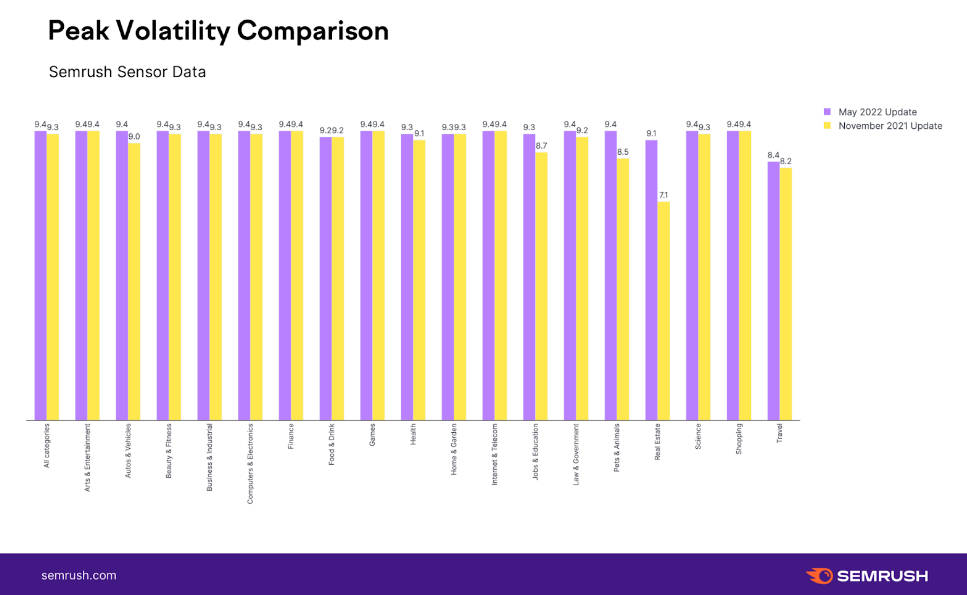
Volatility data from SEMrush did a comparison between May 2022 and November 2021 update across segments. It clearly shows the most affected sectors in this update and how it must have panned out for different website categories.
The May 2022 Core Update was first publicly published by Google one day prior, and the Semrush Sensor detected extremely high amounts of rank changes. The initial spike in extremely high rank volatility, however, only lasted one day. This is consistent with the volatility patterns seen in both the July and the November 2021 Core Updates. Prior to the most recent update, this initial phase of significant rank fluctuation would last 3–4 days or longer. It appears that Google is adopting a much speedier initial increase in rank volatility throughout its core changes. Let’s examine the update’s initial effects and what they indicate for this time’s winners and losers.
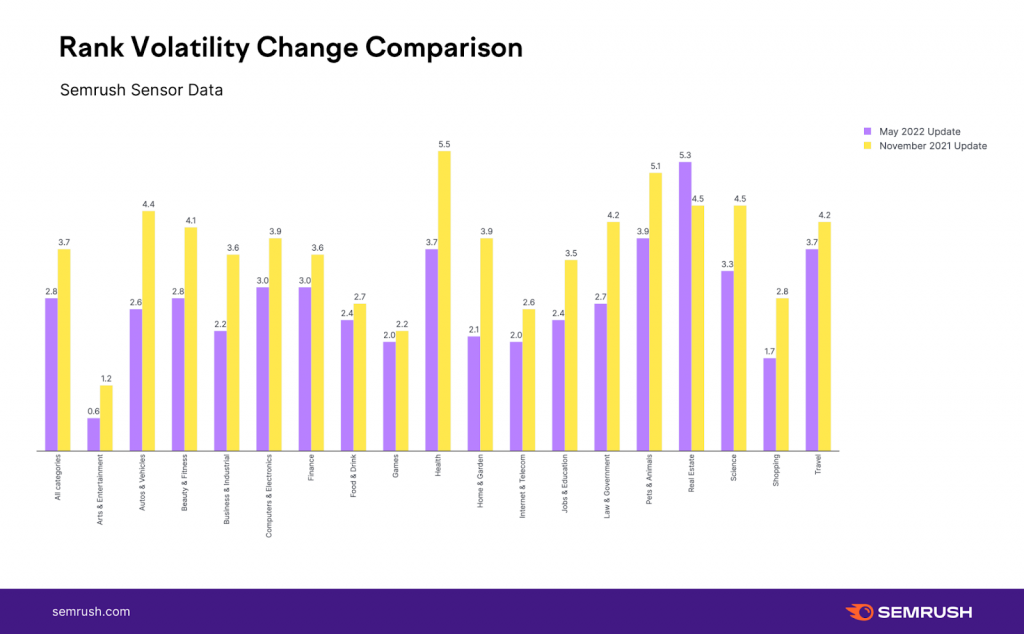
Here, the solution is intricate. Google May 2022 Core Update appears to be just as effective as the November 2021 Core Update when looking at the peak levels of rank volatility. Virtually all verticals had peak levels of volatility during the May update that were upwards of 9/10; Real Estate in particular was substantially higher than it was during the November 2021 Core Update.
On both desktop and mobile devices, the average peak level of volatility was 9.4. This is comparable to the Core Update from November 2021, when peak values on desktop and mobile were 9.3. When viewed from this angle, the May 2022 and November 2021 Core Updates appear to have had an equal impact on rank volatility, but as we close in, it becomes clear that this is not the case. We can observe that the November 2021 Core Update had a far greater impact when we examine the change in the average level of volatility. In particular, the November 2021 Core Update increased the amount of rank volatility on desktop from 5.6 to 9.3 compared to before the update. Comparatively, baseline volatility was much greater before the May 2022 Core Update; the pre-update level on desktop was 6.4 and rose to 9.4 following the update.
The greatest levels of volatility seen throughout both upgrades were relatively similar, but during the November 2021 Core Update, they had to rise even higher. The update in May did not seem to have as much of an impact as the one in November because some residual volatility already existed before it started.
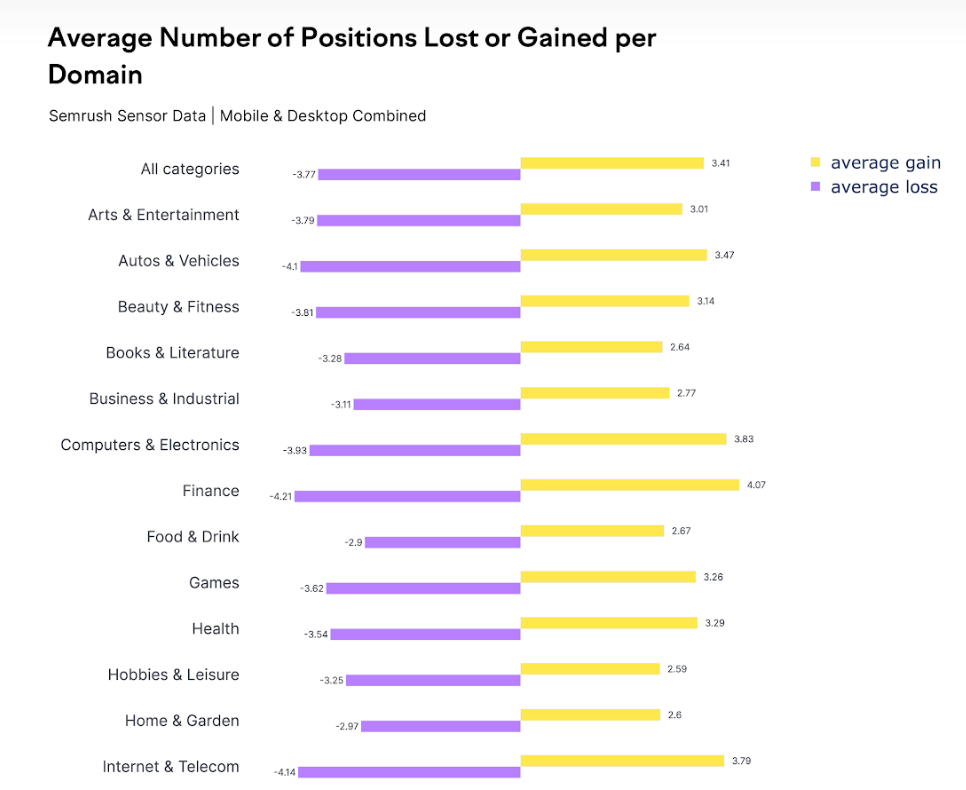
In terms of peak volatility during the May update, desktop and mobile numbers showed to be comparable, with a level of 9.4 being reached on both platforms, when we look at changes per device.
We also looked at the typical gain and loss in position that URLs experienced as a result of the changes in May 2022 in order to more accurately assess how the core update operated. What was the performance of various industries across mobile and desktop combined?
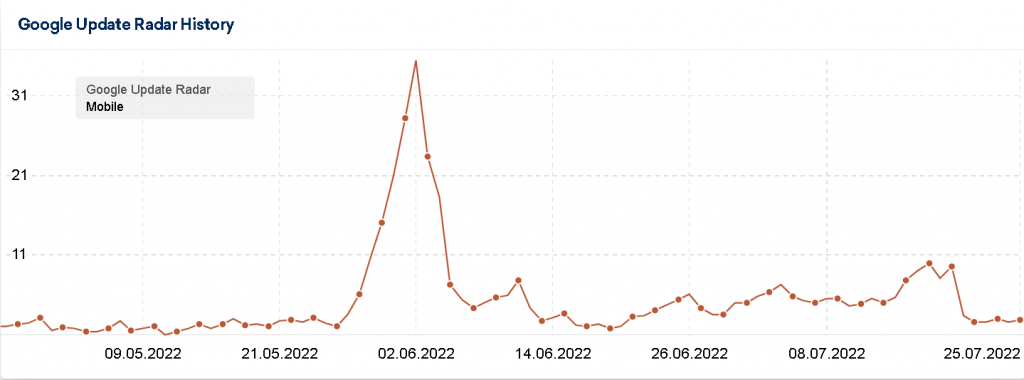
In this graph, you can see the SERPs becoming highly volatile between May 21, 2022 and June 6, 2022. The graph peaked on June 2, 2022, which was towards the end of May core update.
Some verticals, such as Arts & Entertainment and Books & Literature, broke from this pattern, although each one suffered more losses than gains. It is essential to concentrate on producing high-quality content that is pertinent to your audience and takes E-A-T into account.
It is difficult to identify the causes of the differences without focusing on specific examples. They may include things like the content that Google has access to and its propensity to highly reward it, as well as how Google uses SERP elements in any particular vertical.
Algorithm modifications that affect ranks can send the SEO community into a frenzy, but it is important to handle these changes with a long-term perspective. Even though a drop in rankings is genuine, core upgrades can also give sites new chances and even if impacted negatively, there is always the possibility of making improvements that ultimately bring long-term growth.
Websites That Experienced Gains
Google May 2022 core update went without causing too many hurdles for most websites. There were few websites that experienced a sudden boost in traffic. Here are a few of them:
| Domain | Visibility Index 26.05.2022 | Visibility Index 09.06.2022 | Percentage change |
| makeup.uk | 0.4366 | 2.719 | 522.77% |
| norfarchtrust.org.uk | 1.8745 | 9.7604 | 420.69% |
| mya.co.uk | 0.7416 | 3.3313 | 349.20% |
| xxxner.com | 0.2704 | 1.0186 | 276.70% |
| leekes.co.uk | 1.2043 | 4.5021 | 273.84% |
| boomplay.com | 0.4091 | 1.428 | 249.06% |
| rationalwiki.org | 0.4566 | 1.5735 | 244.61% |
| fife.ac.uk | 0.3061 | 1.0508 | 243.29% |
| guitarparty.com | 0.5772 | 1.854 | 221.21% |
| inbrief.co.uk | 0.4529 | 1.4256 | 214.77% |
| deezer.com | 7.6616 | 23.8267 | 210.99% |
| uniprot.org | 0.3405 | 1.0437 | 206.52% |
| carsupermarket.com | 0.5431 | 1.5923 | 193.19% |
| rockettstgeorge.co.uk | 1.0209 | 2.993 | 193.17% |
| doheth.co.uk | 1.1253 | 3.2892 | 192.30% |
| appbrain.com | 0.386 | 1.0795 | 179.66% |
| childline.org.uk | 1.1823 | 3.2265 | 172.90% |
| imperialcollegeunion.org | 0.4715 | 1.27 | 169.35% |
| smule.com | 1.1614 | 3.1029 | 167.17% |
| kenwoodtravel.co.uk | 1.2501 | 3.266 | 161.26% |
Websites That Experienced Losses
While the update boosted traffic for many websites, some sites also lost a lot of traffic due to sudden change in Google algorithm. Here are a few websites that lost traffic due to Google May 2022 core update:
| Domain | Visibility Index 26.05.2022 | Visibility Index 09.06.2022 | Percentage change |
| cia.gov | 7.7196 | 1.6908 | -78.10% |
| lumenlearning.com | 15.3036 | 4.049 | -73.54% |
| circlehealthgroup.co.uk | 4.158 | 1.1901 | -71.38% |
| adl.org | 3.4406 | 1.0667 | -69.00% |
| kiddle.co | 13.4375 | 4.2006 | -68.74% |
| carpetright.co.uk | 3.7619 | 1.4155 | -62.37% |
| bestreviews.guide | 48.1078 | 18.7173 | -61.09% |
| u-buy.co.uk | 3.9657 | 1.5472 | -60.99% |
| wikidiff.com | 6.9176 | 2.7564 | -60.15% |
| fruugo.co.uk | 3.3967 | 1.4024 | -58.71% |
| muckrack.com | 5.1699 | 2.2915 | -55.68% |
| cocofinder.com | 2.728 | 1.2182 | -55.34% |
| mychordbook.com | 6.5068 | 3.1134 | -52.15% |
| pnas.org | 9.6291 | 4.6775 | -51.42% |
| duolingo.com | 12.9357 | 6.3028 | -51.28% |
| datanyze.com | 2.779 | 1.3578 | -51.14% |
| irishtimes.com | 7.3318 | 3.6022 | -50.87% |
| wealthygorilla.com | 5.2126 | 2.5634 | -50.82% |
| nationalworld.com | 6.3825 | 3.1459 | -50.71% |
| bankbazaar.com | 2.1459 | 1.0616 | -50.53% |
Mobile vs Desktop: How The Impact Measures?
According to Gary Illyes of Google, the company uses ‘possibly millions’ of baby algorithms that analyze diverse inputs in addition to its core algorithm. While there have been some rumors about what exactly a ‘baby’ or ‘small’ algorithm is, Illyes only revealed that they can increase crawl rates and hunt for specific signals in content and pages.
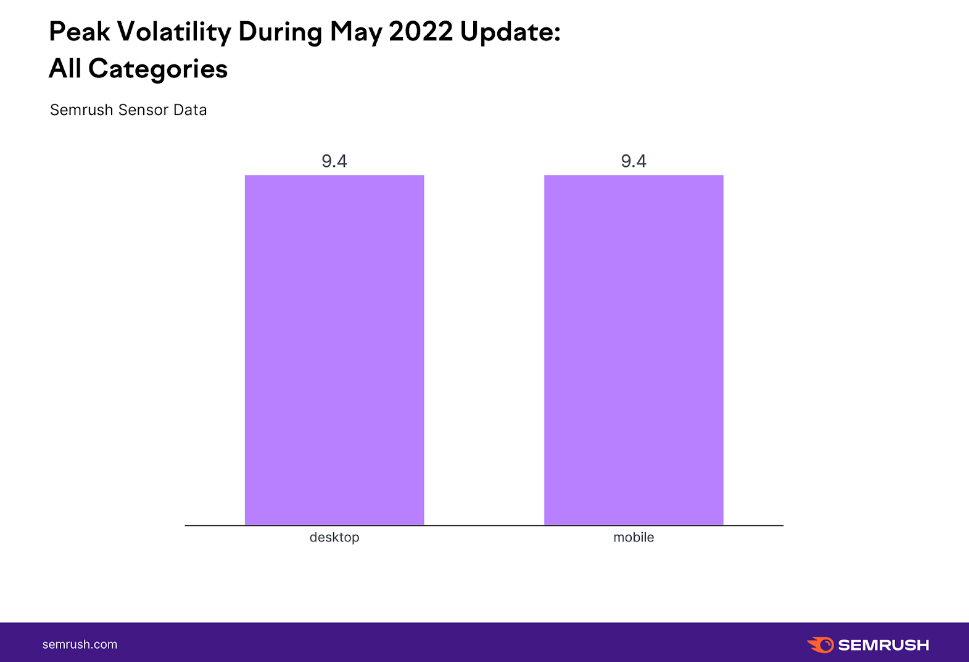
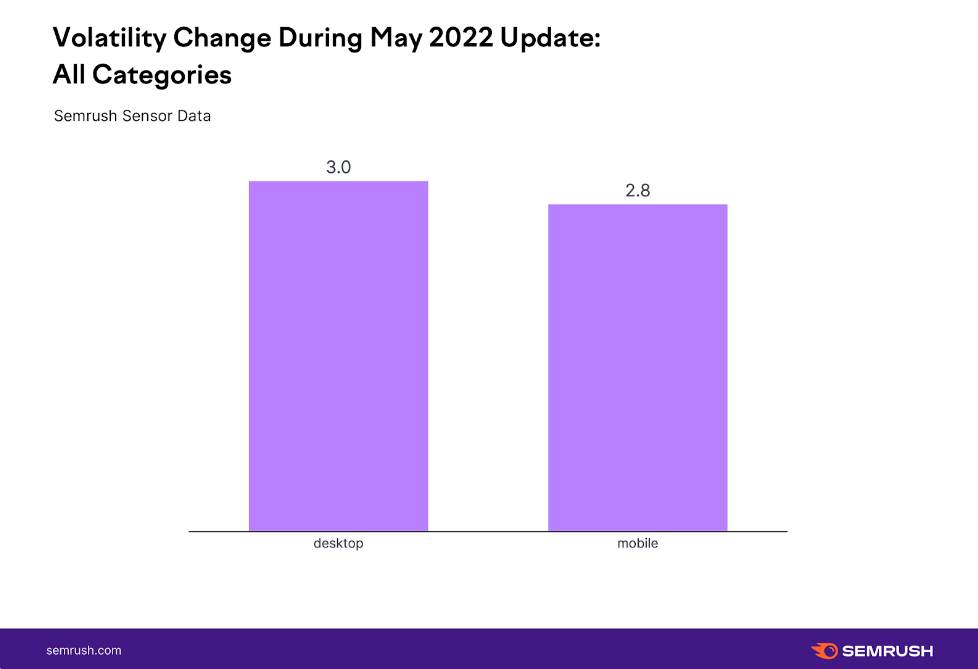
It is also crucial to keep in mind that only three of the tens of thousands of modifications Google makes to its core algorithm each year are considered core upgrades. Google algorithm changed search 4,500 times in 2020, or more than 12 times each day. That number was 3,200 in 2018. Furthermore, in 2020 Google conducted over 600,000 trials. That is a lot of adjustments and experiments, all of which have the potential to affect SERP visibility, traffic, and ranking.
Additionally, the impact is different with mobile and desktop search results. In this update cycle, mobile friendly websites like boomplay.com saw the most positive signs in the form of increased traffic and search visibility. Websites that functioned better with desktop saw their growth stagnate or go down.
This ignores what your search rivals are doing as well as other factors like seasonality, news or events that have an impact on search, and more. Some general core algorithm updates focus only on the device on which the user is making a query. Digging into the data becomes more difficult when the impact is dispersed between devices rather than occurring directly only on one platform.
Due to all of these factors, it may be challenging to attribute ranking declines to a specific Google update. However, some adjustments like making your website mobile friendly do unquestionably affect ranking.
Industries Affected The Most Due To May 2022 Core Update
Like every other update, this update too brought ranking harm for some specific industries. Websites from these industries dropped in search rankings and lost substantial traffic overnight.
News & Media
Analysts studied several websites from different sectors to find out the worst affected sector. After evaluating different studies by Sistrix, SEMrush, and Rank Ranger, we found out that news and media publishers bore the most loss due to this update. The primary loss occurred on generalist domains that write about everything rather than focusing on a single niche. Focused websites that write about a single domain did not experience great loss, however, their traffic too dropped slightly.
Health
Health articles dropped significantly in rankings. Even authority websites that used to rank on the first, second or third position lost significant rankings and saw their articles moved to page two of the search results.
Real Estate
Similar to the last update, real estate websites again lost several of their ranking pages. While some websites saw listings gaining better visibility, others saw a drop in total traffic from listing pages. According to experts, this was primarily due to absence of quality content and relevant information on these pages and following the basic E-A-T method could help websites succeed.
Education
Several education websites lost substantial traffic due to the core update. Some of these include popular names like Schoology.com, Clever.com, Cuny.edu, and Quizziz.com.
Google SERP Changes in May 2022 Core Update
After careful analysis of the core update and its effects, we have pointed out changes in Google SERPs post the core update. Some of these include:
Website search box on page 1
While this is not a new feature from Google, some websites got this for the first time after this update. In this case, a small search box appears just below your website in the SERP. Users are routed to another Google search results page if you do nothing. However, if you implement website schema markup, visitors will instead be directed to your website. In essence, adopting Website schema markup may enable you to obtain a search box in the search results, which may then drive visitors to your website. While it might not be relevant for every website and Google probably will not display it for every page, it might be useful for big businesses or e-commerce.
More relevance of PAA & PASF
Over the past few years, the Google People Also Ask (PAA) feature has gained significant importance as a component of content strategy and SEO (Search Engine Optimization). Digital marketers are even more attracted by the People Also Ask (PAA) function, a SERP addition due to its importance in SEO. Google seems to have upgraded it further in the May 2022 core update. Websites that ideally have relevant questions and answers that could satisfy PAA & PASF content requirements are now ranking better than before.
What Happened in Earlier Broad Core Updates?
Prior to this update, we noted the most recent broad core update occurred in November of 2021. However, the June/July 2021 upgrade actually wins the prize for having the biggest influence on the web. Due to the size of the update, Google decided to break the deployment in two, starting in June and concluding in July. This was mostly unheard about.
As Google Search carried out the June/July 2021 broad core upgrade, data researchers saw a lot of instability for website performances across several industries. Websites also tend to lose their place in featured snippets due to volatility during updates.
It was “one of the larger core updates we’ve seen from Google yet,” according to one expert.
Was the punch in this May 2022 update the same? How did it affect the website of your business? The most crucial question is how did it impact your business and what you need to do. Let’s attempt to learn!
Important Observations From May 2022 Update
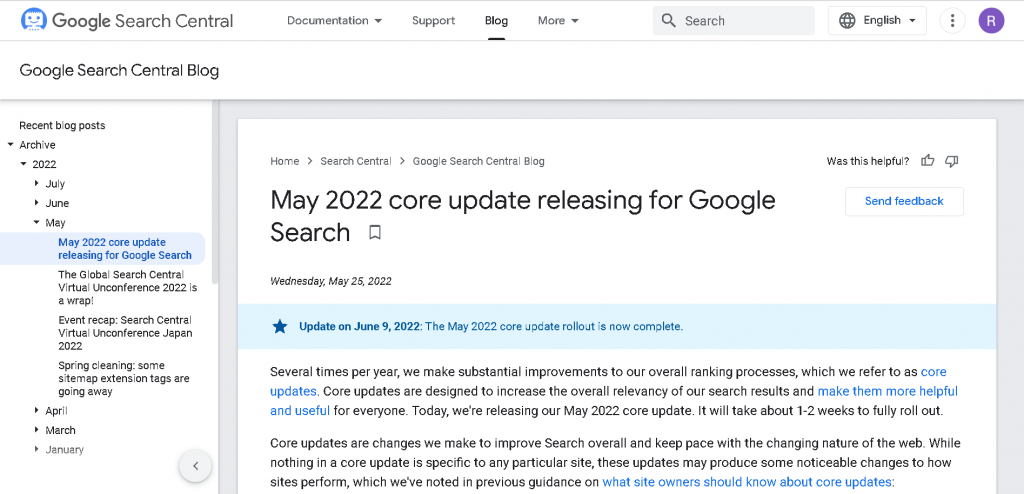
Of course, we are still evaluating the update’s full effects as new developments continue to emerge. However, we looked into the origins of newly ranking URLs if they showed up in the top 10 this time in order to help understand the initial impact and scope of the Google May 2022 Core Update.
According to search observations there were some big ranking movements in May, but it is still unclear whether or not this indicates that Google’s updates consistently have an impact on search engine rankings.
As Google released its May 2022 update post we also examined the top 20 overall results to determine where the newly ranked URLs had been before, in order to better comprehend this. In this case, more than 17% of the top 20 URLs originated from places other than number 20.
Once more, it seems that this was quite similar to the November 2021 Core Update, when 16.2% of new URLs in the top 20 results had not yet reached position 20.
Again, something felt off about this update. It was massive, with a lot of volatility, several powerful tremors that caused sites to reverse course, and the extreme swings in search visibility (particularly across certain YMYL categories) had experts convinced that Google had implemented something new.
There were also many sites (particularly in YMYL) that recovered from previous core update drops despite doing nothing (or very little) to improve overall. This is always visible during broad core updates, but this update seemed to produce more reversals/recoveries than others. And the massive swings back lead people to believe that the change is due to Google rather than the sites themselves.
Google’s ‘Interesting Finds’ Mobile SERP Feature Disappearing With The May Core Update
This is important to understand because it may have an impact on traffic for many websites across the internet (and heavily for some sites). While analyzing client sites following the May broad core update, experts at Pagetraffic noticed that Google’s Interesting Finds SERP feature had vanished. That is significant because the module included a large mobile SERP feature that provided three articles by default and linked to a full listing of 20+ articles.
Furthermore, Interesting Finds allowed sites to appear twice in search results (the same article could rank in the module and in the 10 blue links all within page one of the search results). So, if you notice a drop in traffic after the update, make sure to look at the SERPs for the queries where your site dropped. Another factor contributing to the drop could be your ranking in Interesting Finds.
E-commerce Sites Experience A Drop
Content that has historically ranked well but did not have enough to do with a website’s category or core competency saw a great traffic hit during the update. When the May 2022 broad core update came out, such content took a hit. When that informational content was compared to the core e-commerce site content, the data revealed that the e-commerce portion did not drop at all and the effect only limited to informational content that the website curated over the time. As a result, Google’s algorithms adjusted rankings for the blog content while the core e-commerce section remained visible.
Google never offers any particular information about broad core upgrades. All we know is that Google Search rankings could be severely disrupted by these upgrades.
A week before the core update, the SEO community had conjectured about it, leading many to believe that data updates made during that period were lost. We have observed a lot of major changes in the reference space throughout our own research, including changes to dictionaries and auto information.
Websites With Multilingual Content Saw A Rise In Traffic
Websites that provide content and experience in multiple languages saw a sharp rise in traffic during the may 2022 core update. Google had also targeted these in the updates rolled out during 2021. Despite e-commerce sites losing as a whole, zalando.co.uk saw a rise in traffic since the start of the update. The reason behind this could easily be pointed out towards the site’s ability to serve customers in different languages.
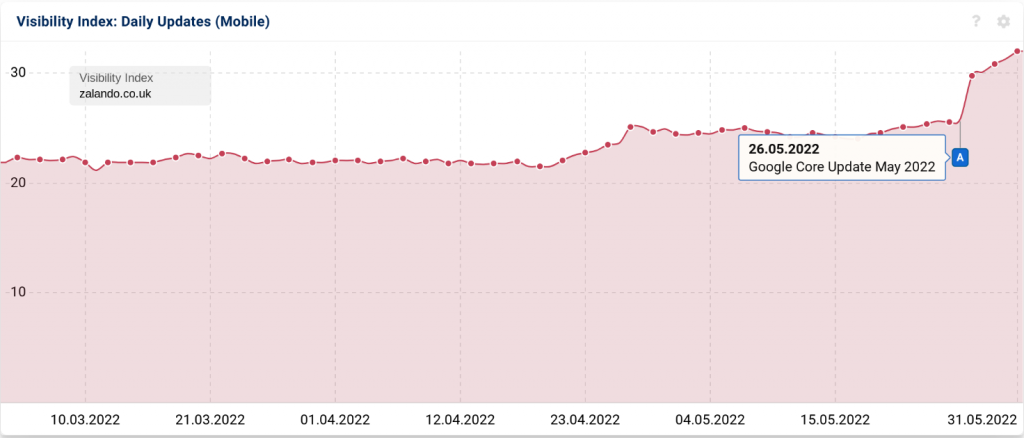
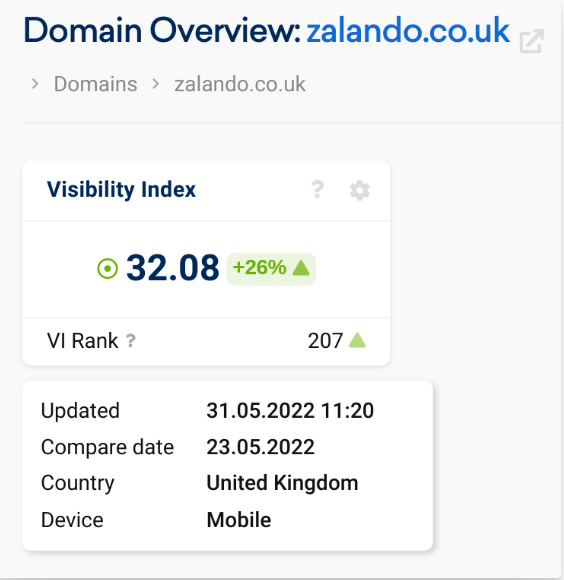
Low Quality Sites Experience Sharp Drop In Traffic
Many low-quality sites that had poor website technicals and/or an inferior content strategy have suffered losses. One website that looks to be selling goods from the USA into the UK is u-buy.co.uk. The site’s reviews can be found on other websites and it has a good backlinking and content strategy. However, the growth rate of a recently ranked website that looks to be an exercise in automation has increased. Lyrics and band information websites are another area with a lot of activity. The majority of the news websites examined experienced a drop in traffic, however independent.co.uk’s topic directory saw a notable increase. Dailymail.co.uk, a rival website, does not use such topic landing pages.
User Generated Content Proved Its Worth
Websites with good user generated content continued to play on the safer side of the algorithm for this update. Most of such websites which we analyzed are huge and therefore attract a lot of users to post their views online. Due to increased user activity and attention, Google continues to promote such websites and niches categories. Top websites in this category improved on-site E-A-T by ensuring that experts wrote and/or reviewed content on the site, emphasizing those experts, providing references and citations, and using structured data to reinforce the content. Structured data is not a ranking factor, but it does provide Google with more context about the content.
Focus On Local: Is This Google’s New Mantra?
Google seems to be working harder than ever on enhancing the local search experience of users. Websites with locally focused quality content and information gained quality traffic after the update. Few websites that also had their technicals strong along with a solid content strategy also pointed out that saw an immediate boost in percentage conversions (pointing towards traffic quality) during the update phase.
What Should You Do After Google May 2022 Core Update?
If your website is affected due to the May 2022 core update or you want to excel in the current scenario, it is important that you learn from the update and implement new measures in your SEO strategy.
The advice from Google is to create excellent content, which is quite standard for Google. While each and everyone interested in SEO who is looking for real insights finds this message to be aggravating, Google has offered plenty of tips and advice over the years about how to develop websites and content that are of a high caliber. The secret is to continually provide top-notch material over time. Your ratings could rise if you do it.
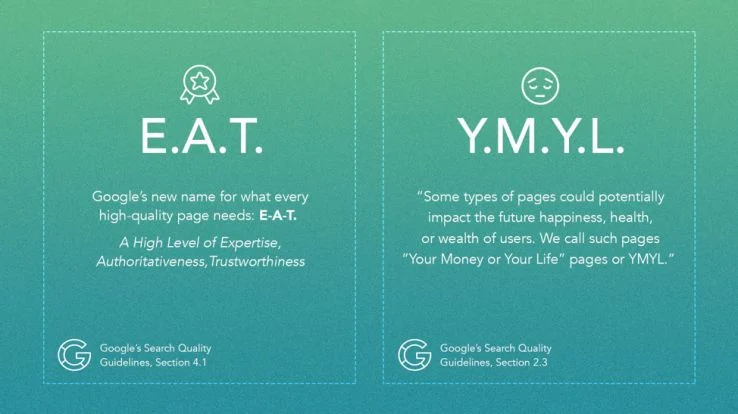
According to Google, assessing your own content in terms of E-A-T criteria may help align it conceptually with the different signals. The letters E-A-T stand for expertise, authority, and trustworthiness. Expertise requires that you demonstrate your knowledge of your field, identify yourself as the Main Content’s (MC) original author, and accentuate this fact throughout the content. Expertise is less important in industries like comedy websites, however it’s necessary for the legal, financial, and medical industries. If the information is accurate and beneficial to visitors, any website can demonstrate knowledge along with content supremacy.
Authoritativeness signifies that you are the Main Content creator’s authority. Authoritativeness can be attained by you, your writers, or both. Have people participate and leave comments on your community page or forum to increase authority.
The Main Content’s consumers should be able to trust the creator, the Main Content, and the website. Websites like e-commerce that request sensitive information, such as credit card numbers, can especially profit if they project trustworthiness as people are more open to sharing their personal details and make transactions if they find that the website can be trusted.
These signals are used by Google’s automated systems to rank content. Improving E-A-T is not a one-day job. It can entail obtaining links and mentions on authoritative sites as well as increasing Google’s understanding of the entities associated with your brand. Further, schema usage can be beneficial. The most powerful external recommendations come from other authorities in your field. However, if you lack real-world experience that can be verified online, you may find it difficult to improve your E-A-T. You can check out our blog post on how to increase E-A-T and get actionable insights for your website SEO development.
Moreover, what site owners should know about Google’s core improvements was shared as a blog post published by Google in August 2019 that contained additional advice. The 23 questions Google issued to offer advice on the Panda upgrade have largely been updated in this post. These questions were divided by Google into four categories:
Content and Quality Related Queries
- Does the article offer original reporting, research, information, or analysis?
- Does the content offer a thorough, comprehensive, or extensive description of the subject?
- Does the information in the piece offer perceptive analysis or intriguing details that go beyond the obvious?
- If the content is based on other sources, does it avoid merely rewriting or replicating those sources instead of adding significant uniqueness and value?
- Does the page title or headline offer a detailed, insightful overview of the content?
- Does the page title or headline refrain from being overly dramatic or shocking?
- Would you want to bookmark, suggest, or share this page with a friend?
- Would you anticipate finding this information in or cited in a printed magazine, dictionary, or book?
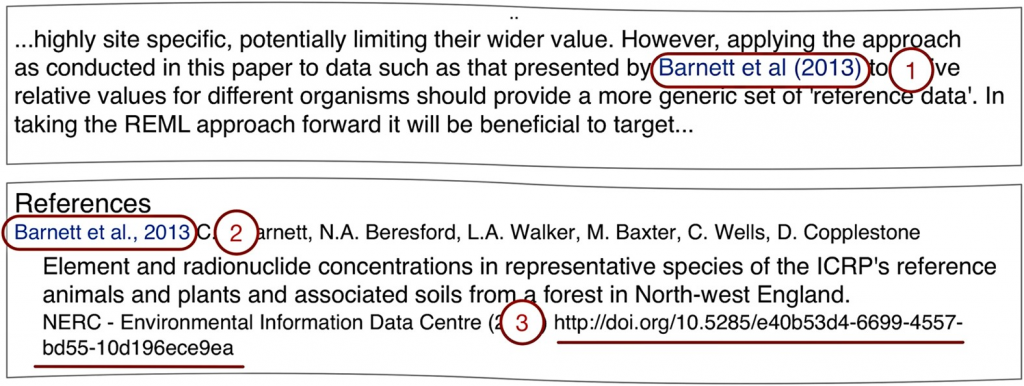
Expertise-Based Queries
- Is the information presented in the content presented in a way that encourages you to believe it, such as with clear sourcing, proof of the author’s subject-matter expertise, or background information about the author or the website that published it, such as through links to an author page or a site’s About page?
- If you did your study on the website that created the content, would you have the idea that it is widely regarded as an authority on its subject?
- Was this article authored by a subject-matter expert or enthusiast who can clearly demonstrate their expertise?
- Are there any easily-verifiable factual inaccuracies in the content?
- Would you feel secure relying on this information for matters involving your life or money?
Questions About Production and Presentation
- Are there any grammatical or stylistic errors in the text?
- Did the content appear to have been rushed or poorly produced?

- Is the content distributed across a vast network of websites or mass-produced by or outsourced to a big number of authors, resulting in a lack of care or attention for specific pages or websites?
- Does the content contain too much advertising that detract from or obstruct the primary content?
- When accessed on mobile devices, does the material display properly?
Credit: Easybib Comparison Issues
- Is the content significantly more valuable than other pages in search results?
- Does the content appear to be meeting the true needs of website users, or does it appear to be the entire product of someone speculating on what would perform well in search engines?
Google added that it is possible for content that has been adversely affected by a broad core algorithm update to remain so until the next core update is made public. But from experience, you may raise your content’s standing by upgrading, editing, or otherwise enhancing it.
Were you affected?
If your website has been hit by the May 2022 core update, we are here to help you regain the lost ground. Our Google penalty recovery specialist will analyze your website and suggest an effective strategy to get into Google’s good books again. Click here to book a meeting with us.
Conclusion
It is possible that the timing of the update had something to do with which industries saw a decline in website traffic. When the situation changes and individuals resume their regular activities, it’s likely that some websites will regain their rankings in the SERP even if nothing is done. It is preferable for sites to wait before making significant adjustments in response to preliminary findings. Above all, review Google’s Search Quality Evaluator Guidelines and Core Updates blog to determine whether your website falls under the category of low-quality or high-quality value. Keep an eye out as we update this blog about further changes that continue being reported post the may 2022 update.
Frequently Asked Questions
How can I improve my Google ranking 2022?
To improve your website rankings in Google search results you must work on website search engine optimization (SEO). While there are some special steps you can take in 2022, most of the key steps are related to general SEO and require continuous work to be done. Nevertheless, here is how you can improve website Google ranking in 2022:
1. Work on your on-page and off page SEO.
2. Improve website technicals.
3. Find relevant keywords for the website.
4. Work on E-A-T.
5. Publish high quality content.
What is a Google broad core update?
A broad core algorithm update is a change to Google’s “core,” or general, search ranking algorithm and processes. The core algorithm used by Google is actually a group of algorithms that analyze signals from web pages (such as keywords, links, etc.) and rank the material that most effectively responds to a search query. For instance, we are aware that Google added Panda to its main algorithm in 2015.
What is latest Google algorithm update?
On May 25, 2022, Google started rolling out its latest algorithm update. The changes took some time to take place and were completed from Google’s side on June 9, 2022. The search engine giant made improvements to its search capabilities during the update causing rank changes for millions of websites across the web.
